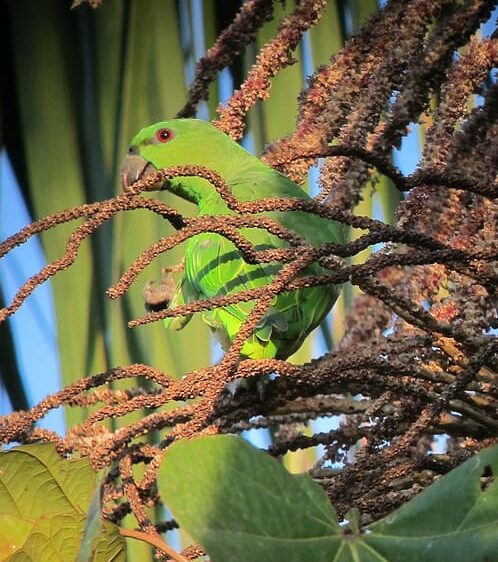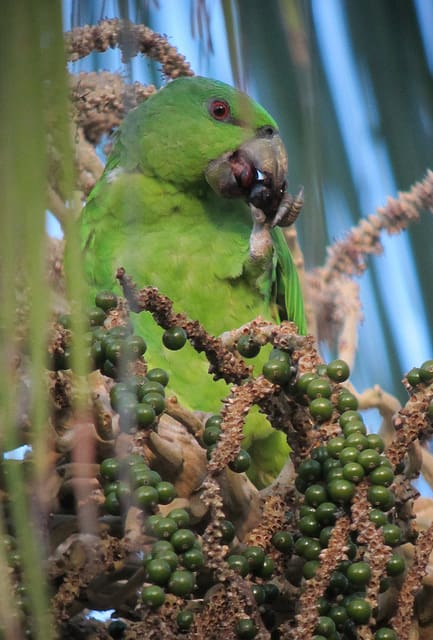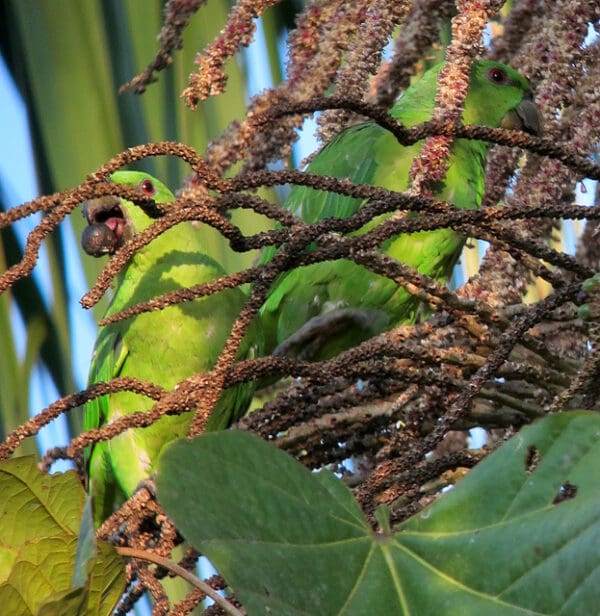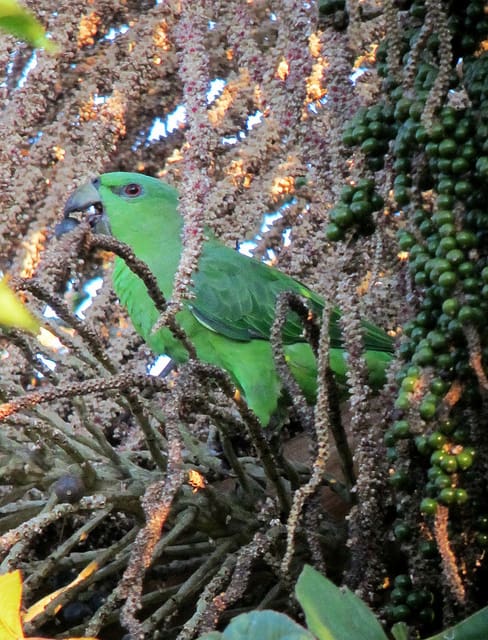DID YOU KNOW?
The Short-tailed Parrot is known as one of the noisiest parrots in the Amazon basin, with its calls being detected at considerable distance.

Graydidascalus

brachyurus
Size:
24 cm (9.3 in)
Weight:
188-233 g (6.6-8.1 oz)
Subspecies including nominate:
one
Colour Adult:
Both adults in general green; green/yellow greater wing coverts, secondary and tertial feathers and scapulars; forewing has dark red area; green tail with dark red at base. Beak green/grey. Eye red.
Colour Juvenile:
As in adults but red at base of tail absent.
Call:
Calls are distinctive, with gurgling notes; calls in flight are harsh and raucous; also two-note series. While feeding emits a series of trilled, horn-like notes.
More Information:
Content Sources:
CITES
BirdLife International
Cornell Lab of Ornithology/Birds of the World
A Guide to Parrots of the World, Juniper and Parr, 1998
Parrots of the World, Forshaw, 2006. 2010 edition
Parrots in Aviculture, Low, 1992.
Lexicon of Parrots, Thomas Arndt.
Captive Status:
Rare
Longevity:
—
Housing:
In a secluded location: aviary or suspended enclosure, minimum length 2 m (6.5 ft).
Diet:
Fruits such as: apple, pear, orange, banana, pomegranate, cactus fruits, forming about 30 percent of the diet; vegetables such as: carrot, celery, green beans and peas in the pod; fresh corn; green leaves such as: Swiss chard, lettuce, sowthistle, dandelion, chickweed; spray millet; small seed mix such as: canary, millet, and smaller amounts of oats, buckwheat, safflower and a little hemp; soaked and sprouted sunflower seed; cooked beans or pulses, boiled maize, and complete kibble.
Enrichment:
—
Nest Box Size:
Vertical box 8″ x 8″ x 16″ (20.3 cm x 20.3 cm x 40.6 cm).
Clutch Size:
3-4
Fledging Age:
—
Hatch Weight:
—
Peak Weight:
—
Weaning Weight:
—
World Population:
Unknown but described as fairly common, decreasing.
IUCN Red List Status:
Least Concern
CITES Listing:
Appendix II
Threat Summary:
Common and sometimes locally abundant. In upper reaches of rivers becomes more scarce, presumably due to restricted habitat. May be affected by ongoing habitat loss. Not generally found in trade.
Range:
SE Colombia, NE Ecuador and NE Peru east along Amazon River to coastal Amapa, N Brazil, and French Guiana.
Habitat:
Found up to 300 m (984 ft) in lowland tropical rainforest, mainly in varzea, river-edge vegetation, forest bordering lakes or other swampy or seasonally flooded areas. In coastal areas seen in secondary growth forest and mangroves.
Wild Diet:
Feeds on Cecropia catkins, Ficus fruits, cultivated fruits including guava Psidium guajava and mango Mangifera indica when available; possibly tuber-like fruits, berries, buds and flowers.
Ecology and Behaviour:
Social birds outside of breeding season. Will associate with other parrot species in the wild. Birds feed mainly in the canopy.
Clutch and Egg Size:
3-4 eggs
Breeding Season:
Possibly September.
Related Links:
—





![© Felix Uribe [CC BY-SA 2.0] via Flickr A wild Short-tailed Parrot forages in a tree](https://gt2024.parrots.org/wp-content/uploads/2023/01/wpt_Short-tailed-Parrot_1401-6-e1730747311650-100x100.jpg)
![© Nick Athanas [CC BY-SA 2.0] via Flickr A wild Short-tailed Parrot perches in a bare tree](https://gt2024.parrots.org/wp-content/uploads/2023/01/wpt_Short-tailed-Parrot_1401-8-100x100.jpg)
![© Felix Uribe [CC BY-SA 2.0] via Flickr A wild Short-tailed Parrot feeds on berrries](https://gt2024.parrots.org/wp-content/uploads/2023/01/wpt_Short-tailed-Parrot_1401-5-100x100.jpg)
![© Felix Uribe [CC BY-SA 2.0] via Flickr Wild Short-tailed Parrots feed on berries](https://gt2024.parrots.org/wp-content/uploads/2023/01/wpt_Short-tailed-Parrot_1401-4-100x100.jpg)
![© Felix Uribe | [CC BY-SA 2.0] via Flickr A wild Short-tailed Parrot feeds on berries](https://gt2024.parrots.org/wp-content/uploads/2023/01/wpt_Short-tailed-Parrot_1401-3-100x100.jpg)